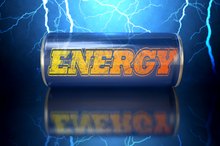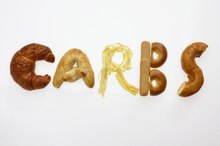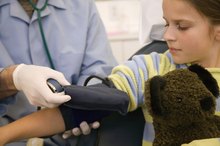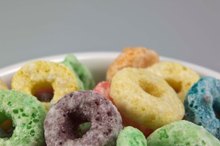Side Effects of a Glucose Drink
Insulin-dependent diabetics can find themselves low on blood sugar if they overdose on insulin or go too long without eating. This is very dangerous to the brain, and quickly leads to coma. Such individuals commonly use glucose drinks to significant benefit and with essentially no side effects. Most individuals who are free from disease have very little reason to use glucose drinks routinely. Glucose drinks may have significant side effects if used by a non-diabetic, however.
Sugar Overdose
One of the first effects of a glucose drink not medically indicated is a simple sugar overdose. While this isn't dangerous, it is associated with some potentially uncomfortable symptoms similar to those an individual would feel if she drank too much soda or ate too much candy. Sugar highs can cause a feelings of excitation, particularly in children. Note Drs.
- One of the first effects of a glucose drink not medically indicated is a simple sugar overdose.
- While this isn't dangerous, it is associated with some potentially uncomfortable symptoms similar to those an individual would feel if she drank too much soda or ate too much candy.
Hypoglycemia
Possible Side Effects of Dextrose
Learn More
Oddly, exceedingly low blood sugar is the second effect of sugar overdose resulting from non-diabetic glucose use. The reason for this paradoxical response is that the body attempts to maintain blood sugar within strict parameters. If levels rise too high in a very short period of time, as they do in the case of sugar overdose, the pancreas secretes large quantities of the hormone insulin, explains Dr. Lauralee Sherwood in her book, "Human Physiology."
Fat Synthesis
The human body is designed to store excess energy for later use. Two primary storage mechanisms include storing glucose as the carbohydrate glycogen in the liver and converting glucose to fat for storage in fat cells, explain Drs. Mary Campbell and Shawn Farrell in their book, "Biochemistry." Very high levels of insulin release that occur following a sugar overdose lead to significant conversion of glucose to fat 2. For this to occur, glucose is partially metabolized to the smaller molecule acetyl-CoA, which is then converted to longer chain fatty acid molecules and eventually triglycerides, or storage fat.
- The human body is designed to store excess energy for later use.
- Two primary storage mechanisms include storing glucose as the carbohydrate glycogen in the liver and converting glucose to fat for storage in fat cells, explain Drs.
Related Articles
References
- “Biochemistry”; Reginald Garrett, Ph.D. and Charles Grisham, Ph.D.; 2007
- “Biochemistry”; Mary Campbell, Ph.D. and Shawn Farrell, Ph.D.; 2005
- “Human Physiology”; Lauralee Sherwood, Ph.D.; 2004
- American Diabetes Association. 5. Lifestyle management: Standards of medical care in diabetes-2019. Diabetes Care. 2019;42(Suppl 1):S46-60. doi:10.2337/dc19-S005
- National Institute of Diabetes and Digestive and Kidney Diseases. Diabetes diet, eating, & physical activity. Published December 2016.
- American Diabetes Association. The big picture: Checking your blood glucose.
- American Diabetes Association. 6. Glycemic Targets: Standards of Medical Care in Diabetes-2020. Diabetes Care. 2020;43(Suppl 1):S66-S76. doi:10.2337/dc20-S006
- American Diabetes Association. 14. Management of diabetes in pregnancy: Standards of medical care in diabetes-2020. Diabetes Care. 2020;43(Suppl 1):S183-S192. doi:10.2337/dc20-S014
- Porcellati F, Lucidi P, Bolli GB, Fanelli CG. Thirty years of research on the dawn phenomenon: Lessons to optimize blood glucose control in diabetes. Diabetes Care. 2013;36(12):3860-2. doi:10.2337/dc13-2088
- American Diabetes Association. 5. Lifestyle management: Standards of medical care in diabetes-2019. Diabetes Care. 2019;42(Suppl 1):S46-60. doi:10.2337/dc19-S005
- Colberg SR, Sigal RJ, Yardley JE, et al. Physical activity/exercise and diabetes: A position statement of the American diabetes association. Diabetes Care. 2016;39(11):2065-2079. doi:10.2337/dc16-1728
- American Diabetes Association (ADA). Understanding A1C.
- Garber AJ, Abrahamson MJ, Barzilay JI, et al. Consensus statement by the American association of clinical endocrinologists and American college of endocrinology on the comprehensive type 2 diabetes management algorithm - 2019 executive summary. Endocr Pract. 2019;25(1):69-100. doi:10.4158/CS-2018-0535
Writer Bio
Kirstin Hendrickson is a writer, teacher, coach, athlete and author of the textbook "Chemistry In The World." She's been teaching and writing about health, wellness and nutrition for more than 10 years. She has a Bachelor of Science in zoology, a Bachelor of Science in psychology, a Master of Science in chemistry and a doctoral degree in bioorganic chemistry.









